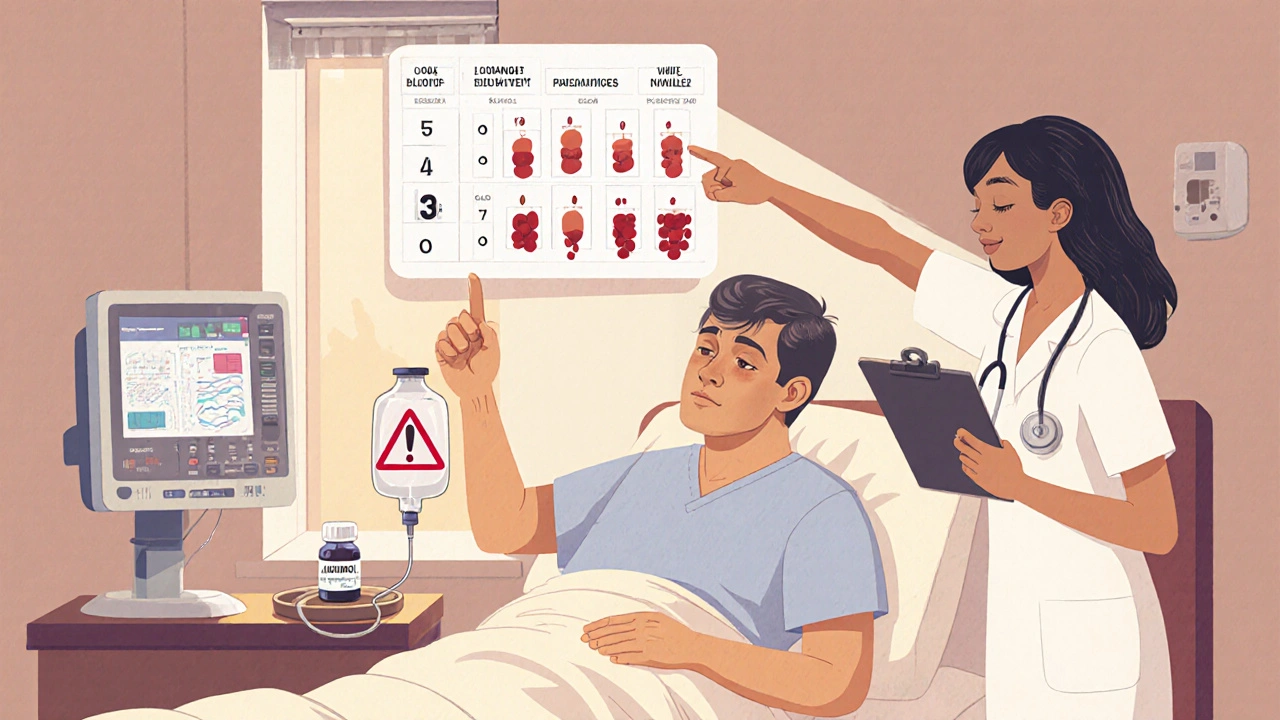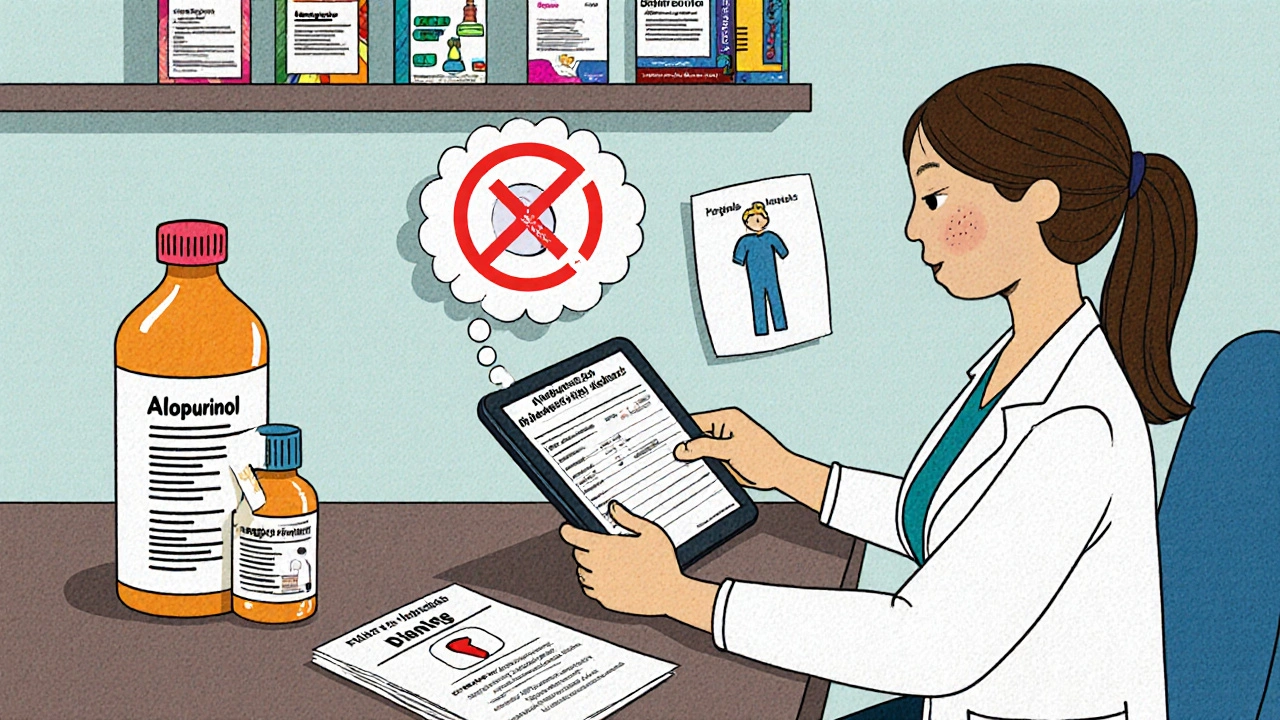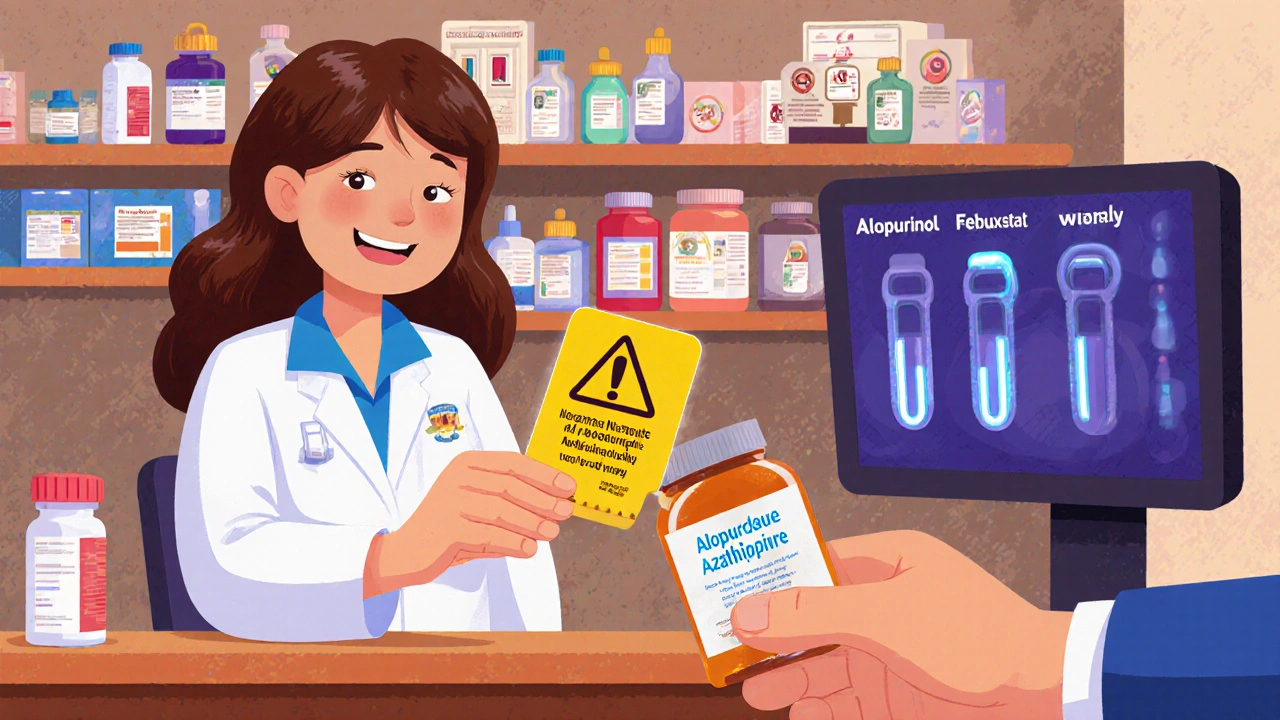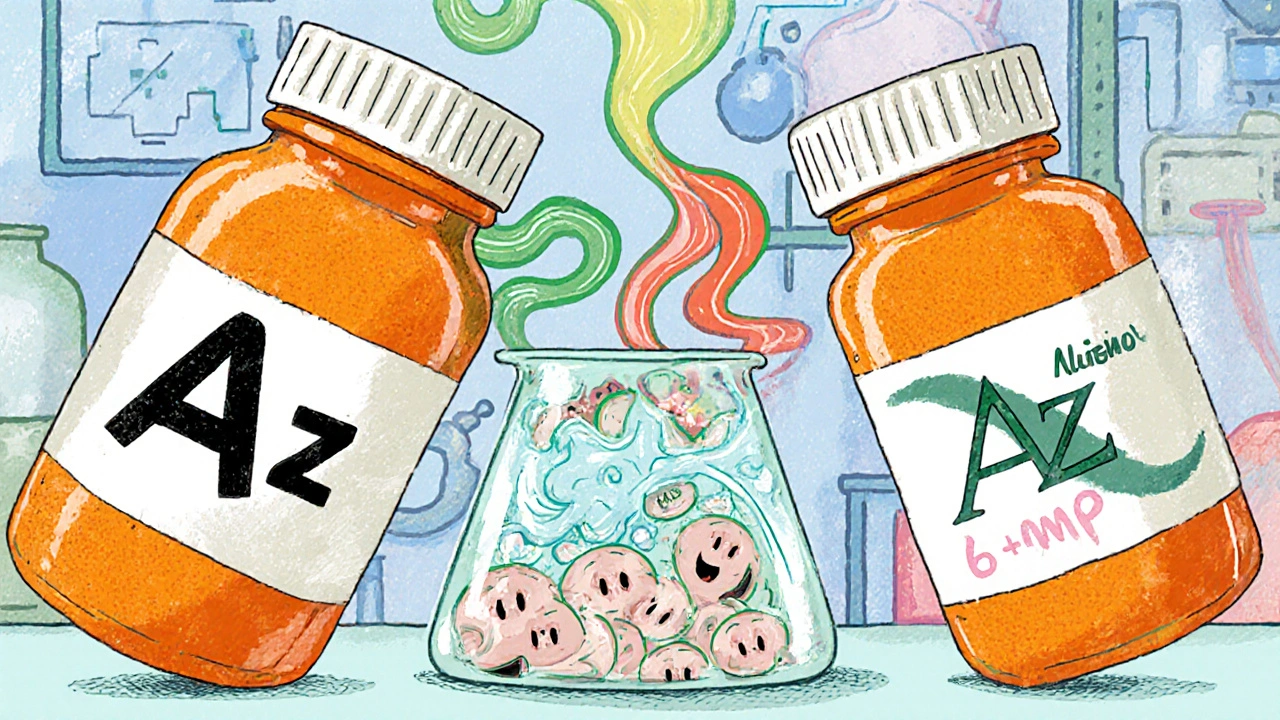Allopurinol-Azathioprine Dose Calculator
This calculator determines the safe azathioprine dose when co-administered with allopurinol. When used together, azathioprine must be reduced to 25% of the standard dose due to a dangerous interaction that can cause severe bone marrow suppression.
Critical Safety Information
Severe bone marrow suppression: This interaction can increase active thiopurine metabolites up to four-fold, causing life-threatening bone marrow suppression.
Monitoring required: Weekly blood counts for the first 12 weeks are mandatory when using this combination.
Metabolite testing: 6-TGN and 6-MMP levels should be monitored to guide therapy.
This combination should only be used in specialized cases with expert oversight.
Note: The 25% dose reduction is based on clinical guidelines. Always consider patient-specific factors and consult appropriate specialist guidance before adjusting therapy.
Key Takeaways
- The Allopurinol azathioprine interaction can raise active thiopurine metabolites up to four‑fold, causing severe bone‑marrow suppression.
- If the drugs must be used together, azathioprine should be cut to about 25 % of the usual dose and blood counts monitored weekly for the first 12 weeks.
- Combination therapy is reserved for specialized IBD cases ("thiopurine shunters") and requires metabolite testing (6‑TGN, 6‑MMP) and expert oversight.
- Patients should be warned explicitly about the interaction; prescribers must screen for allopurinol before starting azathioprine.
- Alternative gout drugs (febuxostat, pegloticase) and other immunosuppressants (methotrexate, biologics) often eliminate the need for this high‑risk pairing.
Allopurinol is a xanthine oxidase inhibitor marketed under names like Zyloprim. It lowers serum uric acid and is a first‑line treatment for gout. Azathioprine is an immunosuppressant (brand name Imuran) used for organ‑transplant rejection, inflammatory bowel disease (IBD) and rheumatoid arthritis. When taken together, the two drugs clash in a way that can be life‑threatening.
Why the Interaction Happens
Both drugs share a metabolic pathway involving the enzyme xanthine oxidase (XO). Azathioprine is converted in the body to 6‑mercaptopurine (6‑MP), which is then metabolized by three routes:
- XO turns 6‑MP into inactive 6‑thiouric acid.
- Thiopurine methyltransferase (TPMT) makes 6‑methylmercaptopurine (6‑MMP), a hepatotoxic metabolite.
- Hypoxanthine‑guanine phosphoribosyltransferase (HGPRT) produces thioguanine nucleotides (6‑TGN), the active anti‑inflammatory agents.
Allopurinol blocks the XO route. With XO shut down, more 6‑MP is forced down the HGPRT pathway, boosting 6‑TGN levels by up to 300‑400 % and cutting 6‑MMP by about 70 %. The surge in 6‑TGN incorporates into DNA of rapidly dividing white‑blood cells, halting their replication and often triggering apoptosis via Rac1 GTP inhibition. The net effect: profound bone‑marrow suppression.
Clinical Consequences You Need to Watch
Case reports paint a stark picture. The first major description (Kennedy et al., 1996) involved a 63‑year‑old heart‑transplant recipient who was on azathioprine 200 mg daily. After a short course of allopurinol for suspected gout, his white‑blood‑cell (WBC) count fell to 1.1 × 10³ mm³, neutrophils dropped below 0.5 × 10³ mm³, platelets sank under 20 × 10³ mm³, and hemoglobin hit 3.7 g/dL. He required blood transfusions, granulocyte‑macrophage colony‑stimulating factor, and a hospital stay costing over $25 k in today’s dollars.
Later reports (ESC365, 2022; Friedman et al., 2018) show similar patterns: pancytopenia, severe infections, and sometimes fatal outcomes when dose‑adjustments are ignored. Laboratory hallmarks include:
- WBC < 2 × 10³ mm³
- Absolute neutrophil count < 0.5 × 10³ mm³
- Platelets < 20 × 10³ mm³
- Hemoglobin < 5 g/dL (in extreme cases)
These numbers demand immediate drug discontinuation, supportive care, and often growth‑factor therapy.

Guidelines for Safe Co‑Prescription
Most authorities agree: avoid the combination unless a specialist decides it’s essential. When it is unavoidable, follow a strict protocol.
| Parameter | Standard Azathioprine Regimen | Adjusted Regimen with Allopurinol |
|---|---|---|
| Azathioprine dose | 2-2.5 mg/kg/day | 0.5-0.75 mg/kg/day (≈25 % of standard) |
| Allopurinol dose | - | 100 mg daily (or 50 mg if renal impairment) |
| Initial CBC monitoring | Baseline + every 2-3 months | Weekly for first 12 weeks |
| Subsequent CBC | Every 3 months | Monthly after week 12 |
| Therapeutic 6‑TGN target | 230-450 pmol/8×10⁸ RBC | Same range, but achieved at lower azathioprine dose |
| 6‑MMP ceiling | < 5 700 pmol/8×10⁸ RBC | Aim for < 5 700, often naturally reduced |
Key points from the Medsafe (NZ) and FDA guidelines:
- Screen every new azathioprine patient for existing allopurinol therapy.
- If allopurinol is already prescribed, switch azathioprine to the 25 % dose before starting the gout drug.
- Maintain weekly complete blood counts (CBC) for the first three months, then shift to monthly checks.
- Document patient consent and provide written warnings about the interaction.
When the Combination is Actually Useful
In a subset of IBD patients, standard azathioprine produces high 6‑MMP (hepatotoxic) and low 6‑TGN (ineffective). These “thiopurine shunters” can benefit from low‑dose azathioprine plus allopurinol, a strategy called thiopurine‑allopurinol co‑therapy.
Friedman et al. (2018) randomized 73 shunters to 50 mg vs 100 mg allopurinol with reduced azathioprine. Results:
- 53 % achieved steroid‑free remission.
- 81 % discontinued steroids.
- 100 mg allopurinol lowered 6‑MMP more effectively than 50 mg.
Later work (Turbayne et al., 2022) linked therapeutic 6‑TGN levels to lower fecal calprotectin (128 µg/g vs 297 µg/g, p < 0.05), indicating real mucosal healing.
Because the regimen demands tight metabolite monitoring and dose tweaks, it’s limited to gastro‑enterology centers with experienced pharmacists.

Practical Steps for Clinicians
- Check the medication list. Before starting azathioprine, verify the patient isn’t on allopurinol (or vice‑versa).
- Adjust azathioprine dose. Reduce to 0.5-0.75 mg/kg/day if allopurinol will be added.
- Order baseline labs. CBC, liver function tests, renal function, TPMT genotype/phenotype, and thiopurine metabolites (6‑TGN, 6‑MMP).
- Start allopurinol. Typical dose 100 mg daily; halve if eGFR < 30 mL/min.
- Monitor CBC weekly. Look for falling neutrophils or platelets; hold both drugs if WBC < 2 × 10³ mm³.
- Re‑measure metabolites after 4 weeks. Titrate azathioprine to keep 6‑TGN 230-450 pmol/8×10⁸ RBC and 6‑MMP < 5 700 pmol/8×10⁸ RBC.
- Educate the patient. Provide a printed card stating, “Do NOT start gout medication without telling your doctor if you are on azathioprine.”
Failure to follow any of these steps has been linked to hospitalizations in > 30 % of published case series.
Patient Education Checklist
- Explain why the two drugs don’t mix.
- Give a list of common gout meds (allopurinol, febuxostat, probenecid) and warn only allopurinol is high‑risk.
- Advise immediate reporting of fever, sore throat, bruising, or unusual fatigue.
- Encourage regular blood‑test appointments and bring results to every visit.

Future Directions & Alternatives
Newer gout agents-febuxostat and pegloticase-don’t inhibit XO, so they bypass the interaction entirely. For immunosuppression, methotrexate, mycophenolate, or biologics (anti‑TNF, anti‑integrin) can replace azathioprine in many cases, removing the risk.
Pharmacogenetics is also gaining ground. TPMT and NUDT15 testing can predict who will accumulate toxic thiopurine metabolites, allowing clinicians to pre‑emptively adjust doses or avoid the combination.
Ongoing trials like TAILOR‑IBD (2023) are testing precision‑dosing algorithms that incorporate metabolite levels, TPMT status, and renal function. Early data suggest remission rates near 70 % with acceptable safety, hinting that the high‑risk combo may become safer with smarter monitoring.
Bottom Line
The Allopurinol azathioprine interaction is a classic drug‑drug clash that can turn a routine gout prescription into a life‑threatening emergency. Avoidance is the safest route; if avoidance isn’t possible, cut azathioprine to a quarter of the usual dose, monitor blood counts weekly, and watch metabolite levels closely. Specialty centers use the combo deliberately for IBD patients who can’t tolerate standard thiopurine therapy, but they do so with a strict protocol and expert oversight.
Why does allopurinol increase azathioprine toxicity?
Allopurinol blocks xanthine oxidase, the enzyme that normally inactivates 6‑mercaptopurine (the active metabolite of azathioprine). With XO inhibited, more 6‑MP is converted into thioguanine nucleotides, which suppress bone‑marrow production and can cause severe pancytopenia.
What dose of azathioprine should I use if a patient needs allopurinol?
Reduce azathioprine to roughly 25 % of the standard dose-about 0.5-0.75 mg/kg/day-once allopurinol (usually 100 mg daily) is started. Adjust further based on weekly CBC and metabolite levels.
How often should blood tests be done during combination therapy?
Check a complete blood count weekly for the first 12 weeks, then move to monthly monitoring if counts remain stable. Liver function and renal labs should be checked at the same intervals.
Can I use febuxostat instead of allopurinol to avoid the interaction?
Yes. Febuxostat lowers uric acid without inhibiting xanthine oxidase, so it does not raise thiopurine metabolite levels. It’s a safer gout alternative for patients on azathioprine.
Is the allopurinol‑azathioprine combo ever approved for routine use?
No. Both the FDA and EMA list the combination as contraindicated except under specialist supervision for specific IBD scenarios. It remains a niche, high‑risk strategy.

Tamara Tioran-Harrison
October 25, 2025 AT 13:51It is utterly astonishing that such a pedestrian exposition on drug interactions persists in the modern literature, as if we were still in the Dark Ages of pharmacology. One would expect a seasoned clinician to have internalised the perilous nature of allopurinol‑azathioprine co‑prescribing long ago, yet here we are, re‑hashing basics with the enthusiasm of a novice. The author’s reliance on archaic tables instead of dynamic decision‑support tools betrays a complacency that is, frankly, commendable in its audacity. 😊
kevin burton
October 25, 2025 AT 15:15When combining allopurinol with azathioprine, the key is to reduce the azathioprine dose to roughly 0.5‑0.75 mg/kg per day and to monitor a complete blood count weekly for the first twelve weeks. This schedule catches any early drop in neutrophils or platelets before serious infection can develop. Additionally, checking thiopurine metabolite levels after four weeks helps fine‑tune the dose without excessive trial and error.
Max Lilleyman
October 25, 2025 AT 16:38Honestly, anyone who skips the weekly CBC in this scenario is flirting with disaster 🤦♂️. The literature is crystal clear: a precipitous fall in WBC below 2 × 10³ mm³ demands immediate drug interruption. Ignoring this protocol is not just careless-it’s a textbook case of medical negligence.
Brett Witcher
October 25, 2025 AT 18:01The ostensible simplicity of dose reduction belies the nuanced pharmacogenomic considerations that underpin optimal therapy.
Terell Moore
October 25, 2025 AT 19:25It is a curious sociological phenomenon that the medical community continues to parade the allopurinol‑azathioprine interaction as a mere footnote rather than a profound illustration of the hubris inherent in polypharmacy. One must contemplate whether the clinicians who prescribe these agents possess an epistemological humility worthy of their oath, or whether they are simply enamoured with the allure of “more is better.” The mechanistic dance between xanthine oxidase inhibition and thiopurine metabolism serves as a perfect allegory for the unintended consequences of unchecked intervention. When the enzyme that ordinarily disposes of 6‑MP is silenced, the metabolic flux is rerouted, flooding the cellular milieu with thioguanine nucleotides that indiscriminately sabotage hematopoietic progenitors. This cascade is not an abstract biochemical curiosity; it is a visceral reminder that biology resists simplistic manipulation. The textbook guidance to truncate azathioprine to a quarter of its conventional dose is, in itself, a compromise that betrays a reluctant concession to the limits of our therapeutic imagination. Moreover, the insistence on weekly CBCs for a tri‑monthly period reflects a paternalistic surveillance that, while safeguarding, also underscores a failure to devise more elegant solutions. One could argue that the very existence of such a high‑risk regimen is an indictment of our reliance on antiquated drugs when newer, more selective agents are available. Yet the inertia of clinical practice is formidable, bolstered by entrenched guidelines and the comfort of familiarity. In this milieu, the role of the specialist becomes that of a gatekeeper, arbitrating who may tread the narrow path of co‑therapy with the requisite vigilance. The philosophical irony is palpable: we mitigate one risk only to introduce another, all in the pursuit of therapeutic efficacy. Perhaps the ultimate lesson resides not in the minutiae of dosing tables but in the broader contemplation of whether we, as stewards of patient health, should accept such precarious compromises at all. As we navigate these treacherous waters, let us not forget that the patient’s lived experience-fatigue, bruising, the terror of infection-transcends the sterile elegance of a protocol. In the final analysis, the interaction is less a pharmacological footnote and more a clarion call for a paradigm shift toward precision medicine.
Olivia Harrison
October 25, 2025 AT 20:48I completely understand how overwhelming all these dosing adjustments can seem, especially when you’re already managing a chronic condition. Rest assured, by following the step‑by‑step monitoring plan-weekly blood counts, periodic metabolite checks, and clear communication with your healthcare team-you can greatly reduce the risk of serious complications. If you ever feel uncertain, don’t hesitate to reach out to your pharmacist or physician for clarification; they are there to support you every step of the way.
Bianca Larasati
October 25, 2025 AT 22:11Behold! The drama of a single lab value slipping below the threshold, a silent scream echoing through the marrow! Yet silence can be broken with a simple blood draw.
Corrine Johnson
October 25, 2025 AT 23:35Consider, if you will, the paradoxical nature of modern therapeutics; we seek precision, yet we cling to antiquated regimens-an elegant contradiction, a wondrous folly!; The very act of prescribing allopurinol alongside azathioprine, without heed to metabolite monitoring, is tantamount to inviting chaos into the bloodstream; therefore, one must ask: is the pursuit of remission worth the gamble with marrow?; In the end, the answer lies not in statistics, but in the moral calculus of the clinician’s conscience.
Jennifer Stubbs
October 26, 2025 AT 00:58From a risk‑benefit standpoint, the allopurinol‑azathioprine combination offers a modest increase in remission rates for a specific subset of IBD patients, yet it also carries a disproportionately high incidence of severe cytopenias when monitoring lapses. Quantitative analyses reveal that for every 10 patients treated under strict protocols, approximately one will experience clinically significant bone‑marrow suppression-a figure that cannot be dismissed lightly. Consequently, the decision to employ this regimen should be reserved for cases where alternative therapies have unequivocally failed, and only after comprehensive patient counseling and consent.